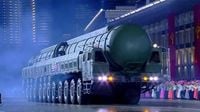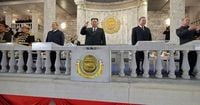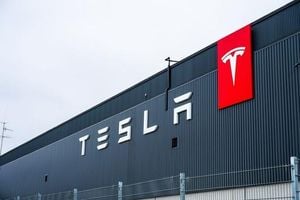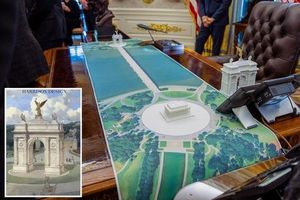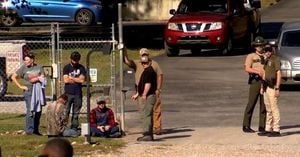On a rain-soaked evening in Pyongyang, North Korea put on a display that reverberated far beyond its borders. Marking the 80th anniversary of the ruling Workers’ Party on October 10, 2025, the regime unveiled its latest and most formidable intercontinental ballistic missile (ICBM), the Hwasong-20, in a grand military parade that drew the eyes of the world—and the attendance of powerful allies. The parade, a blend of spectacle and strategic messaging, offered a window into the country’s growing military ambitions, deepening international ties, and shifting geopolitical currents.
The Hwasong-20, described by North Korea’s official Korean Central News Agency (KCNA) as the military’s “most powerful nuclear strategic weapon system,” took center stage. Mounted on an 11-axle launcher truck, the missile’s debut marked a significant leap in North Korea’s weapons program. The existence of the Hwasong-20 had only been revealed in recent weeks, following tests of a new solid-fuel rocket engine made with carbon fiber, capable of producing a staggering 1,971 kilonewtons of thrust—more powerful than any earlier North Korean rocket engine, as noted by KCNA and reported by CNN.
Military analysts took note. “The Hwasong-20 represents, for the moment, the apotheosis of North Korea’s ambitions for long-range nuclear delivery capabilities. We should expect to see the system tested before the end of this year,” said Ankit Panda of the Carnegie Endowment for International Peace, as reported by Reuters. The missile is widely believed to be designed to carry multiple nuclear warheads, a feature that would complicate U.S. missile defense systems and potentially allow North Korea to penetrate those defenses more effectively. “Multiple warheads will increase stresses on existing US missile defence systems and augment what Kim sees as necessary to achieve meaningful deterrence effects against Washington,” Panda added, underscoring the strategic rationale behind the new missile.
The parade was about more than hardware. It was a demonstration of North Korea’s evolving alliances. Kim Jong Un, flanked by foreign dignitaries—including Russia’s Deputy Security Council head Dmitry Medvedev, China’s Premier Li Qiang, and Vietnam’s Communist Party chief To Lam—used the occasion to send a message of unity against what he called the “threat of the West’s global hegemony.” In his speech, Kim declared, “Today, we stand before the world as a mighty people with no obstacles we cannot overcome and no great achievement we cannot accomplish,” according to KCNA.
But the symbolism ran even deeper. For the first time, North Korean soldiers who had fought alongside Russian forces in Ukraine marched in the parade, carrying the flags of both nations. According to The New York Times, South Korean officials estimate North Korea has provided Russia with 15,000 troops and large shipments of artillery shells, rockets, and missiles to support Moscow’s ongoing military campaign in Ukraine. The parade thus honored these soldiers, with Kim emphasizing North Korea’s commitment to “fulfill their responsibilities in the joint struggle of the progressive mankind for opposing injustice and hegemony and defending justice and peace.”
Medvedev, representing Russia, expressed gratitude for North Korea’s steadfast support. “The nature of relations between people and between countries is revealed during times of trial,” he said on the Russian social media platform Max, as quoted by Reuters. “This fully applies to the alliance between our countries. We are grateful to the Democratic People’s Republic of Korea for its steadfast support of the special military operation. Our soldiers stood shoulder to shoulder to liberate the Kursk region. This feat will forever remain in our hearts.” Kim, in turn, voiced hopes to “strengthen cooperation with Russia and to closely engage in diverse exchanges to achieve common goals,” KCNA reported.
The presence of such senior Russian and Chinese officials in Pyongyang was not lost on observers. According to The New York Times, the attendance of Premier Li Qiang—China’s second-highest-ranking official—marked the first visit by a Chinese premier to North Korea since 2009. Analysts interpret this as a sign of North Korea’s rising value to both Beijing and Moscow as strategic competition with the United States intensifies. Seong-Hyon Lee, a senior fellow at the George H.W. Bush Foundation for U.S.-China Relations, remarked, “When the same formulaic term [denuclearization] vanishes from multiple official documents within weeks, it signals intentional policy shift, not bureaucratic oversight.” Russia, for its part, has signaled that denuclearization is now a “closed” matter, while China has stopped mentioning the issue in official statements following high-level meetings with North Korea.
The parade was also a showcase of North Korea’s military modernization. Alongside the Hwasong-20, the event featured long-range strategic cruise missiles, military drones, tanks equipped with modern electronic warfare gear, and hypersonic ballistic missiles. These displays, as noted by The New York Times and Reuters, are part of Kim’s ongoing effort to leverage new weapons programs for both domestic propaganda and international bargaining power. Under his leadership, military parades have grown not just in size but in geopolitical significance.
Yet, questions remain about the true capabilities of North Korea’s latest missile. While the Hwasong series has expanded the country’s reach, experts point to lingering doubts about the sophistication of its guidance systems and whether its warhead payloads can survive atmospheric re-entry. Still, the move toward missiles capable of carrying multiple warheads marks a significant step in Pyongyang’s pursuit of a credible deterrent against Washington. President Lee Jae Myung of South Korea recently warned that North Korea was nearing the ability to target the U.S. mainland with nuclear warheads.
The timing of the parade added another layer of intrigue. It came less than three weeks before the Asia-Pacific Economic Cooperation (APEC) meetings in South Korea, where international leaders—including those from the United States, China, and Russia—were expected to gather. The spectacle in Pyongyang, with Kim flanked by top Chinese and Russian officials, sent a clear signal: North Korea is no longer content to play the role of a client state. Instead, it seeks to position itself as an indispensable partner in a collective challenge to Western strategic dominance.
For Washington, the message was unmistakable. The established playbook for dealing with North Korea—rooted in demands for denuclearization and isolation—may be rapidly becoming obsolete. Kim’s willingness to supply Russia with weapons and troops, combined with the shift in attitudes from Beijing and Moscow, has left the United States facing a more assertive and interconnected bloc of adversaries. As the world’s attention turns to upcoming diplomatic summits, the ripple effects of North Korea’s parade—and its new missile—are sure to be felt in capitals far beyond Pyongyang.
In the end, North Korea’s 80th Workers’ Party anniversary parade was more than a celebration; it was a declaration. With the unveiling of the Hwasong-20 and the embrace of powerful allies, Kim Jong Un signaled his intent to reshape the region’s security landscape—one missile, and one alliance, at a time.
